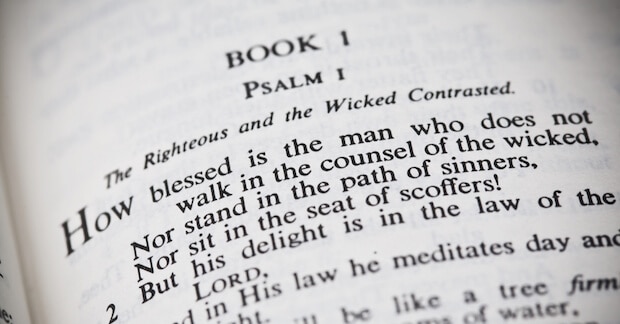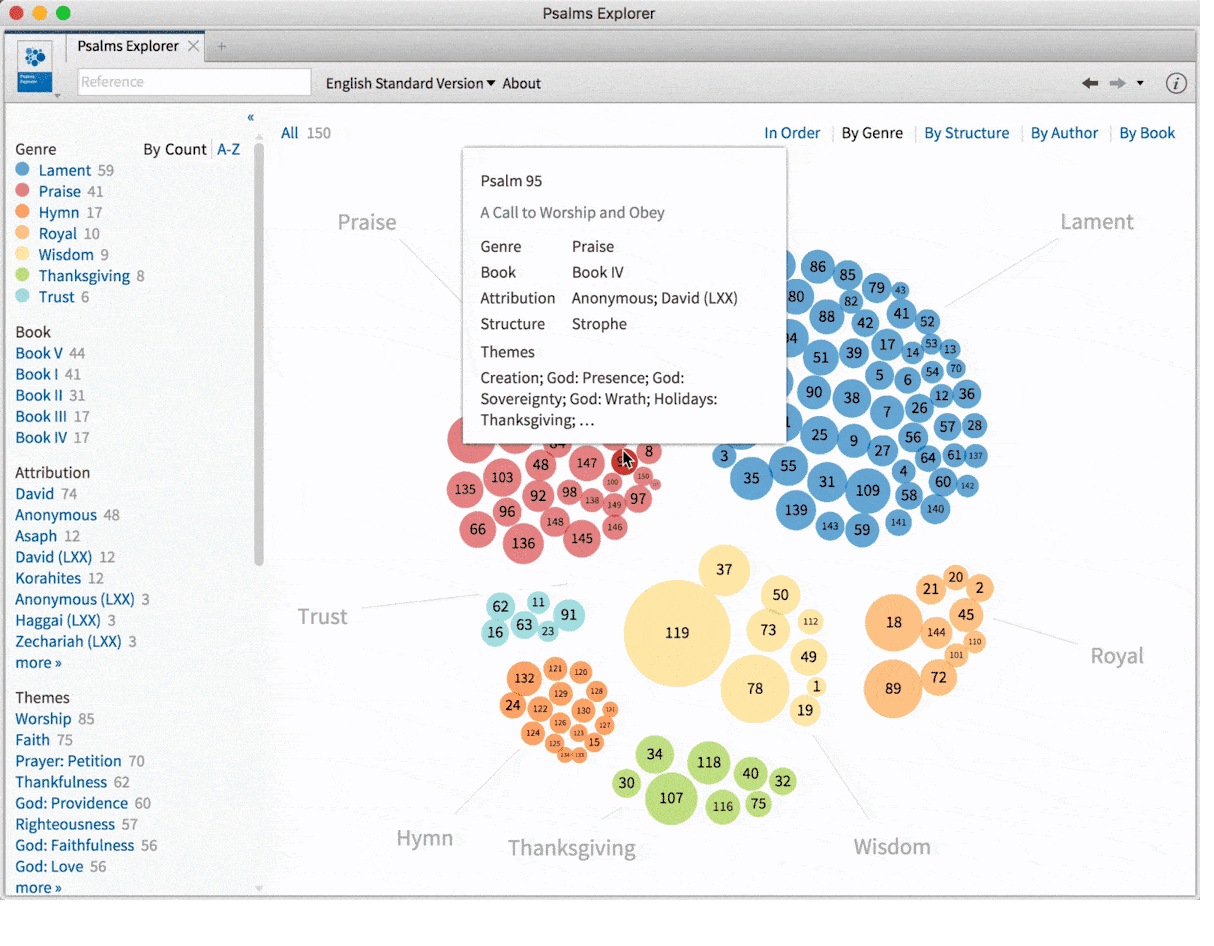Many Christians are faithful Bible readers, but they feel stuck when it comes to Bible study. After you’ve read a Bible passage once, and then read it again, what do you do to study it? Um, read it again? And then what?
Looking at a commentary or study Bible isn’t a bad idea; it’s a good one. But the more study you can do before you turn to one of those tools, the more you’ll get out of them, and the more you’ll get out of your study. The gold you dig up for yourself will be of more value to you—even if all you dig up is a burning question—than what others dig up for you (Prov 2:1–6).
The psalms are a favorite book for God’s people, in part because the study is easier. The meaning of the psalms often, at least, feels plain and practical—even if the application is simply “praise God.” But there is always greater depth in the Bible, and if you want to dig down there you’ll need tools.
Pick up three tools
I work for a Bible study tool company, but the first tool you should pick up is not necessarily Logos Bible Software. First grab your conceptual tools: observation, interpretation, and application.
We’ll do that in a series of three posts. Today: observation. Next week: interpretation. The next week: application.
Step 0. PRE-OBSERVATIONS
We’re going to take a look at Psalm 44, and let’s start with some quick pre-observations you need to make before doing any study in the psalms. Your Bible itself will supply much of this information, but a commentary introduction like Derek Kidner’s or an Old Testament Introduction like Arnold and Beyer’s are also things you’ll want to have available before your study “officially” begins.
Who wrote this?
The superscription above this psalm says it was written by “the sons of Korah.” (Not everyone believes the superscriptions are part of inspired Scripture, but I side with Kidner, who points out that the New Testament authors viewed the superscriptions as accurate.) A little searching in my Bible on “the sons of Korah” reveals that they were most likely Levites serving in the temple as doorkeepers and singers (1 Chr. 6:31, 33, 39, 44).
All good Bible interpretation, as with all good everything, begins with love: you love your neighbor enough to figure out something about who he was before you read his words—knowing that it’s unlikely you’ll understand him if you have no idea who he is.
To whom did the author write this?
The audience of the psalm is not immediately clear; we’ll have to table that one. But it’s a “maskil” given to the “choirmaster,” the superscription says, so it’s apparently some kind of worship song for the ancient Israelites.
You will naturally read the psalm with a different set of expectations than if it were written in a diary by an individual who never had any audience in mind but himself and God. Knowing the audience does affect your reading: it matters, for example, whether the epistle to the Hebrews was written to Jewish Christians or not. (It apparently was, or the massive number of OT references would be odd.)
When did the author write this?
The date this psalm was composed also is not clear. But keep an Old Testament introduction handy—such as Arnold and Beyer’s Encountering the Old Testament—and you’ll be able to get a studied opinion. In fact, that very book mentions Psalm 44 in its section on the sons of Korah:
Certain psalms credited to the sons of Korah reflect the time of the Babylonian exile or later (Pss 44, 85). (emphasis mine)
Even if the psalm you’re studying can’t be dated with specificity (even David’s psalms don’t always give details about when in his life they were written), you need to place the psalm somewhere within the overall story of Scripture. Most simply, the psalms all come after Moses (who wrote Psalm 90) and before Jesus.
If you don’t grasp the overall story of Scripture and where Psalm 44 fits in it, it may be confusing that the psalm never references Jesus, or that it refers to “our armies” (v.9), or that it makes other references which will feel foreign to a contemporary church-going Christian.
What kind of literature is this?
This is not a tightly reasoned epistle nor is it a narrative. It is not an apocalypse or a Gospel. It’s a psalm. It’s a poem using the common Hebrew literary form called parallelism.
The psalms themselves divide into sub-genres such as psalms of lament, praise, and ascent. Here, in fact, are the genres of the psalms as depicted by the Psalms Explorer in Logos. Psalm 44 is marked as a lament, which we’ll confirm as we read it.
If you don’t know the genre of Psalm 44—if you try to read it as straightforward prose—the parallelism may just feel like unnecessary repetition, the apparent lack of hope will feel off theological key, and the poetic tropes will feel overdone (“the place of jackals,” “the shadow of death”).
Having wiped the lenses on our observational glasses, we can commence the observing.
Step 1. OBSERVE: Take in the psalm as a literary whole
I use Logos at the first stage of my study mainly because of what it does not do for me, namely clutter up my view of the text with a bunch of stuff I don’t need at the moment—like footnotes and verse numbers and cross references. The Visual Filters feature in Logos strains out all the little gnats so I can step back and look undistractedly at the camel.
My goal as I read through Psalm 44 in a personal Bible study session is to trace the thought flow at a broad level.
The psalm opens with a first-person plural reference to the Israelites (“We have heard . . . , our fathers have told us”). But first-person singulars occur, too (“You are my King, O God”). This is an individual speaking on behalf of the nation. As soon as someone points this out, it’s obvious, but it takes real discipline—s-l-o-w-i-n-g d-o-w-n—to notice such things. Any Bible study tool that helps you slow down and really focus on what you’re seeing will likely be helpful.
Now for that thought-flow. I like to look for the equivalent of paragraphs, sentences that hang together and serve the same topic. My ESV has already divided the psalm into paragraphs, and I’ll use them as my baseline.
The first paragraph opens beautifully, with praise to God for his powerful and gracious work of planting Israel in their land:
For not by their own sword did they win the land,
nor did their own arm save them,
but your right hand and your arm,
and the light of your face,
for you delighted in them.
The second paragraph goes on to express perfect confidence in Yahweh. The Lord is the one who saves, not military technology:
For not in my bow do I trust,
nor can my sword save me.
But you have saved us from our foes
and have put to shame those who hate us.
In God we have boasted continually,
and we will give thanks to your name forever.
Up to the third paragraph (which begins in verse 9), it sounds like a praise psalm. And, in fact, some church lectionaries use it as such, simply dropping out the last two thirds of the psalm. That doesn’t sound like a good idea to me, because the psalm undergoes a surprising and radical shift that puts the opening paragraphs in a new light:
But you have rejected us and disgraced us
and have not gone out with our armies.
You have made us turn back from the foe,
and those who hate us have gotten spoil.
You have made us like sheep for slaughter
and have scattered us among the nations.
The psalmist is defensive in paragraph 4, proclaiming his and his people’s innocence. They didn’t do anything to deserve the divine rejection they’ve experienced:
All this has come upon us,
though we have not forgotten you,
and we have not been false to your covenant.
The psalm includes notes of hope even after the radical shift, but the notes of exasperation threaten to overwhelm it. The confidence the psalmist had in the Lord at the beginning of the psalm is still present, but it’s a confused and struggling faith that fills the final paragraph:
Awake! Why are you sleeping, O Lord?
Rouse yourself! Do not reject us forever!
Why do you hide your face?
Why do you forget our affliction and oppression?
For our soul is bowed down to the dust;
our belly clings to the ground.
Nonetheless, you don’t pray to a God you don’t believe can do anything to help you. And the last words of the psalm zero in on precisely that characteristic of God which is most relevant in a time like the one the psalmist is experiencing, one of the characteristics of God most central to God’s own self-definition (1 John 4:8): God’s loyal love.
Rise up; come to our help!
Redeem us for the sake of your steadfast love!
At this stage of the observation process, I don’t want to get bogged down with questions about the meanings of difficult words or phrases—unless they seem necessary for grasping the overall thought-flow of the psalm. Probably the only example of such a phrase in this psalm is “Ordain salvation for Jacob!” in verse 4. This is where Bible background knowledge is likely to be needed. If you’ve read the Old Testament, you probably know that “Jacob” is often a stand-in for the nation of “Israel.” Otherwise this psalm uses fairly simple and straightforward wording. The riches in this psalm are found not so much at the word level but at the structural level. How can I describe such a wrenching shift from praise to despair?
Step 2: Outline
I’m going to try to focus that question by means of an outline. Not every passage of Scripture falls neatly into an outline, but Psalm 44 does, and capturing it helps me distill the thought-flow of the psalm into a small set of concepts that I can easily hold in my head. Here is how Bruce Waltke outlines the psalm in his excellent commentary on the book:
- Confidence 1–8
- Lament 9–16
- Protest 17–22
- Petition 23–26
Some Bible students have been critical of efforts to distill and outline Bible passages. It feels reductive to them, like it domesticates the artistry of the Bible. The inspired psalmist didn’t say, “Confidence, lament, protest, petition.” He said Psalm 44. But such an outline is the forest; the individual statements in the psalm are the trees. You don’t have to have either one or the other; you can keep both in mind. In my study, I like to write an outline like this into my notes for Psalm 44 (something you can do in Logos by right-clicking on Psalm 44:1 and adding a note).
We have observed.
Observations
Language is built into humans, and built into language is the importance of context. You can’t not consider the context of a given speech utterance. Your mind is adept at searching for the context that will make the best sense of what you’ve heard; it happens automatically. And that’s the problem when it comes to written communication, especially very old or culturally foreign writing. That’s why you’ve got to slow down and retrain yourself. You’ve got to step into the shoes of the original writers and readers of the Bible in order to close the gap between you and them. You can’t dig for treasure in ancient Israel unless you go there first.
Come back next week and we’ll talk about the interpretation of Psalm 44.
***








